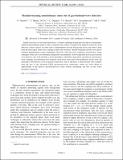Machine-learning nonstationary noise out of gravitational-wave detectors
Author(s)
Vajente, G.; Huang, Yiwen; Isi Banales, Maximiliano S; Driggers, J. C.; Kissel, J. S.; Szczepańczyk, M. J.; Vitale, Salvatore; ... Show more Show less
DownloadPhysRevD.101.042003.pdf (2.285Mb)
Publisher Policy
Publisher Policy
Article is made available in accordance with the publisher's policy and may be subject to US copyright law. Please refer to the publisher's site for terms of use.
Terms of use
Metadata
Show full item recordAbstract
Signal extraction out of background noise is a common challenge in high-precision physics experiments, where the measurement output is often a continuous data stream. To improve the signal-to-noise ratio of the detection, witness sensors are often used to independently measure background noises and subtract them from the main signal. If the noise coupling is linear and stationary, optimal techniques already exist and are routinely implemented in many experiments. However, when the noise coupling is nonstationary, linear techniques often fail or are suboptimal. Inspired by the properties of the background noise in gravitational wave detectors, this work develops a novel algorithm to efficiently characterize and remove nonstationary noise couplings, provided there exist witnesses of the noise source and of the modulation. In this work, the algorithm is described in its most general formulation, and its efficiency is demonstrated with examples from the data of the Advanced LIGO gravitational-wave observatory, where we could obtain an improvement of the detector gravitational-wave reach without introducing any bias on the source parameter estimation. Keywords: Gravitational wave detection; meteorology; gravitational waves
Date issued
2020-02Department
MIT Kavli Institute for Astrophysics and Space ResearchJournal
Physical Review D
Publisher
American Physical Society
Citation
Vajente, G. et al. "Machine-learning nonstationary noise out of gravitational-wave detectors." Physical Review D 101 (February 2020): 042003 @2020 American Physical Society.
Version: Final published version
ISSN
2470-0029
2470-0010